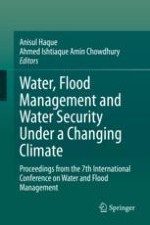2020 | OriginalPaper | Buchkapitel
Analysis on Flow and Water Balance Parameters of Teesta River Basin due to Climate Change and Upstream Intervention
verfasst von : Reazul Zannah, Khaled Mohammed, Afeefa Rahman, Anika Yunus
Erschienen in: Water, Flood Management and Water Security Under a Changing Climate
Aktivieren Sie unsere intelligente Suche, um passende Fachinhalte oder Patente zu finden.
Wählen Sie Textabschnitte aus um mit Künstlicher Intelligenz passenden Patente zu finden. powered by
Markieren Sie Textabschnitte, um KI-gestützt weitere passende Inhalte zu finden. powered by
